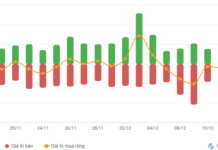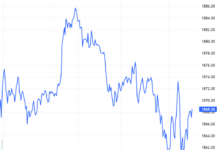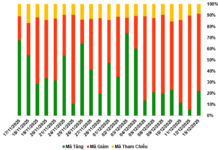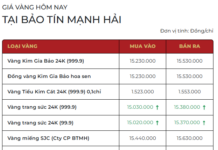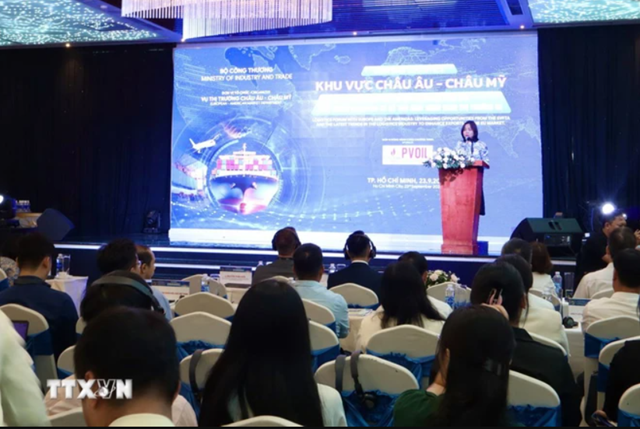
European-American logistics forum. (Photo: Xuan Anh/VNA)
|
On September 23rd, the Ministry of Industry and Trade’s Europe-America Market Department organized a forum on European-American logistics in Ho Chi Minh City. The theme of the forum was “Seizing opportunities from EVFTA and logistics changes to support exports to the EU market.”
Ms. Nguyen Thao Hien, Deputy Director of the Europe-America Market Department, Ministry of Industry and Trade, informed that 2024 marks the fourth year of the effectiveness of the Vietnam-EU Free Trade Agreement (EVFTA). Over the years, EVFTA has acted as a lever to help Vietnam and the EU maintain their growth momentum in bilateral trade cooperation, despite the negative impacts of the COVID-19 pandemic and geopolitical conflicts.
In the first eight months of 2024, bilateral trade between Vietnam and the EU reached nearly 45 billion USD, up 15.8%. Vietnam’s exports to the EU reached 34.1 billion USD, up 17.4% compared to the same period in 2023.
According to Ms. Hien, these figures reflect the economic recovery in the EU and the adaptability of Vietnamese businesses in taking advantage of the opportunities brought about by EVFTA, including the positive contributions from Vietnam’s logistics sector and its partners in the EU.
However, Vietnam’s import and export activities with the EU are also facing challenges due to the unpredictability of the market, the fragile recovery of consumer demand in the EU, and the ongoing geopolitical and military conflicts in many regions. In addition, export destinations, especially the EU, are increasingly demanding the greening of value chains, including production and transportation of goods.
In this context, to increase export efficiency, along with the efforts of manufacturing enterprises, Vietnam’s logistics sector needs to continue improving infrastructure, enhancing operational capabilities, and reducing costs to remain competitive.
Mr. Chandler So, Executive Director of GEODIS Vietnam, said that Vietnam’s participation in multiple FTAs such as CPTPP and EVFTA has boosted production for exports. Trade wars and the pandemic have forced manufacturers to diversify their transportation networks. These factors have contributed to Vietnam’s emergence as a leading manufacturing hub in ASEAN.
Vietnam is currently the EU’s 16th largest trading partner, 3rd largest export market, and 5th largest import market. Vietnam mainly exports telephones, electronic products, footwear, machinery equipment, and textiles to the EU. Meanwhile, the EU exports computers and electronic components, machinery and instruments, pharmaceuticals, chemical products, and animal feed to Vietnam.

Mr. Chandler So, Executive Director of GEODIS Vietnam, sharing information on Vietnam-EU relations at the forum. (Photo: Xuan Anh/VNA)
|
Mr. Carlos Zepeda, a senior maritime economist, said that production growth and related input demands have driven Vietnam’s maritime trade over the past 20 years. A large population and proximity to major markets are the main drivers of Vietnam’s industrial competitiveness.
Links to regional value chains, along with low labor costs, have made Vietnam an export base for many multinational companies, with some degree of concentration. This has laid the foundation for the development of Vietnam’s logistics industry to meet the needs of transporting exported goods.
However, the logistics service industry is still in its infancy in Vietnam and faces many limitations, such as infrastructure investments focusing on quantity rather than quality, as most port facilities are small-scale and not built to meet industrial needs. Ports and industrial zones are often separate, making infrastructure integration difficult.
Regarding trade relations with the EU, expert Carlos Zepeda said that Vietnam is emerging as a major consumer and fashion supplier to Europe, second only to China and Turkey.
Vietnam has also positioned itself as a leading supplier of other value-added products, becoming the third largest high-tech product supplier after China and the United States. With the current production growth rate, it is predicted that container trade volume between Vietnam and Europe could double by 2050.
According to the expert, the factors affecting Vietnam’s production and exports are raw materials, energy, market size, labor and expertise, business environment, supply chain integration, and infrastructure. Vietnam needs to improve its infrastructure, integrate large-scale port operations, and combine them with industrial zones to maximize efficiency and reduce logistics costs.
Mr. Tran Ngoc Quan, Commercial Counsellor of the Vietnam Trade Office in the EU and Belgium, shared that before the COVID-19 pandemic, logistics activities in the EU developed strongly. However, after the pandemic, many ports faced a severe shortage of human resources. The Russia-Ukraine conflict has limited the operation of many ports and sea routes in Russia and Ukraine, and interrupted rail transport. Tensions in the Red Sea have further complicated the transportation of goods to and from the EU.
Sea freight rates from Vietnam to the EU have more than doubled since the beginning of 2024, and many containers of low-value products have become less competitive due to high transportation costs.
In this context, the EU continues to require a transformation in the logistics system, notably the application of technology and digitalization to reduce labor demands, cooperation and innovation to improve efficiency and cut costs. In addition to the Carbon Border Adjustment Mechanism (CBAM), Vietnamese exporters need to pay attention to the EU’s emission control requirements for maritime transport, which could increase international logistics costs.
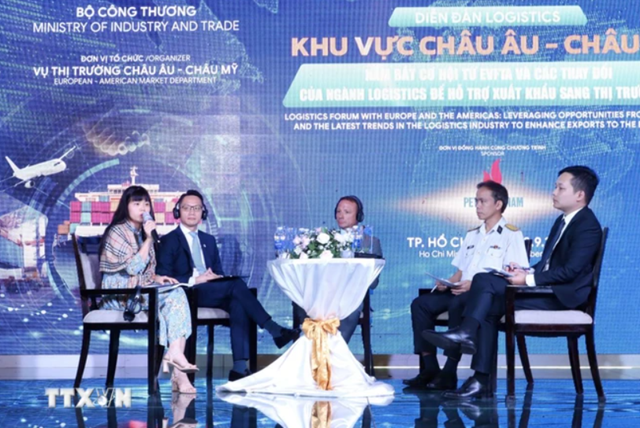
Experts sharing information about the logistics system at the forum. (Photo: Xuan Anh/VNA)
|
Mr. Truong Tan Loc, Marketing Director of Tan Cang Saigon Port, shared that the challenge for Vietnamese port enterprises is limited infrastructure, which can only accommodate vessels with a capacity of up to 14,000 Teu, while vessels from the EU often have a capacity of 24,000 Teu.
Additionally, in the past 2-3 years, the economic downturn and reduced consumer demand in major markets have significantly decreased the volume of goods transported through ports. Vietnam’s large export markets, such as the US and the EU, have experienced constant fluctuations, with rapid increases followed by sharp declines. Volatile freight rates have also impacted port operations.
In the context of developed markets, especially the EU, demanding green standards for supply chains, Tan Cang Saigon Port has proactively transitioned to a solar energy system, automated cargo handling processes, and adopted clean energy for transportation.
Xuan Anh
“T&T and the Aspiration to Connect Infrastructure”
Vietnam is a leader in Asia when it comes to infrastructure investment, allocating 5.7% of its GDP annually. While the majority of funding still comes from the state, an increasing number of large private corporations are stepping up to invest in infrastructure, sharing the burden with the state budget.
The Green Revolution: SuperPort Vietnam’s Net-Zero Emissions Pledge and Regional Supply Chain Connectivity Drive
On September 14, with the attendance of provincial leaders, members of the ASEAN Business Advisory Council (ASEAN BAC), and prominent association and business leaders in the region, SuperPort Vietnam, a joint venture between YCH Group (Singapore) and T&T Group (Vietnam), unveiled its “New Vision for SuperPortTM Vietnam.”
“The $166 Million ‘Super-Hub’: Connecting 20 Industrial Parks to Major Sea and Air Ports”
A Bold Vision for Seamless Supply Chain Connectivity Across China and Southeast Asia with a Net Zero Pledge by 2040.
Recently, SuperPort Vietnam, a joint venture between YCH Group (Singapore) and T&T Group (Vietnam), unveiled its new vision for the future.


